Nationality American Role Artist Name Eva Hesse | ||
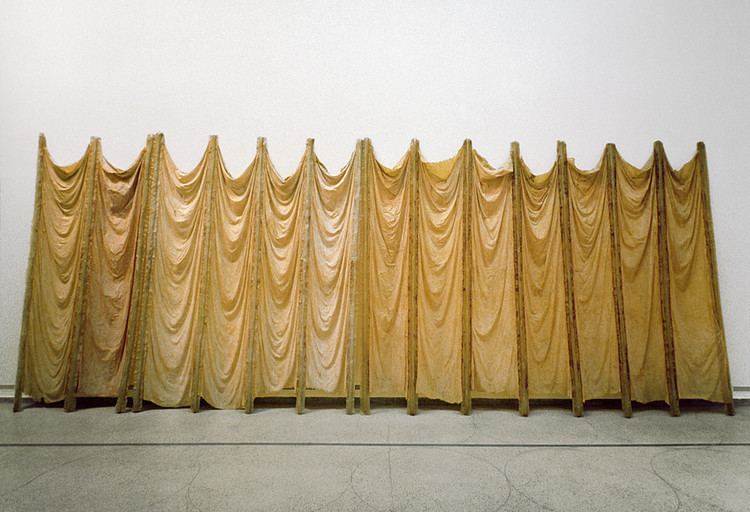 | ||
Influenced by Louise Bourgeois, Marcel Duchamp, Carl Andre, Willem de Kooning Education Yale School of Art (1957–1959) Periods Contemporary art, Postminimalism, Modern art, Minimalism Artwork Repetition Nineteen III, Untitled or Not Yet, Ringaround Arosie Similar People | ||
Eva hesse edinburgh art festival 2009
Eva Hesse (January 11, 1936 – May 29, 1970), was a Jewish German-born American sculptor, known for her pioneering work in materials such as latex, fiberglass, and plastics. She is one of the artists who ushered in the postminimal art movement in the 1960s.
Contents
- Eva hesse edinburgh art festival 2009
- Eva hesse
- Life
- Career
- Methods materials and processes
- Movements
- Visual and critical analysis
- Preservation
- Legacy
- Exhibitions
- List of selected works
- References

Eva hesse
Life
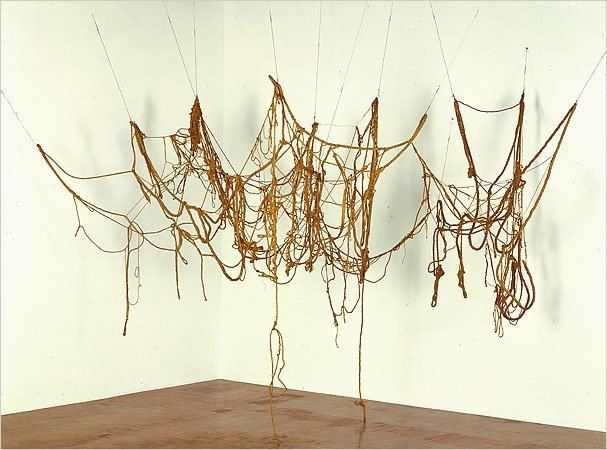
Hesse was born into a family of observant Jews in Hamburg, Germany, on January 11, 1936. When Hesse was two years old in December 1938, her parents, hoping to flee from Nazi Germany, sent Hesse and her older sister, Helen Hesse Charash, to the Netherlands via Kindertransport.
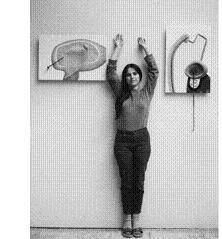
After almost six months of separation, the reunited family moved to England and then, in 1939, emigrated to New York City, where they settled into Manhattan's Washington Heights. In 1944, Hesse's parents separated; her father remarried in 1945 and her mother committed suicide in 1946. In 1962, she met and married sculptor Tom Doyle (1928 - 2016); they divorced in 1966.
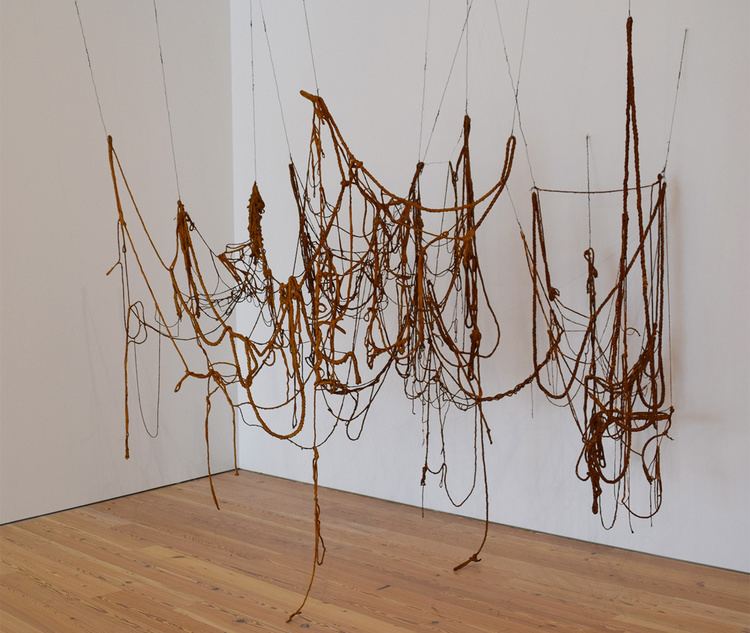
In October 1969, she was diagnosed with a brain tumor, and she died on Friday, May 29, 1970. Her death, after three operations within a year, at age 34 ended a career spanning only 10 years.
Career

Hesse graduated from New York's School of Industrial Art at the age of 16, and in 1952 she enrolled in the Pratt Institute of Design. She dropped out only a year later. When Hesse was 18 years-old, she interned at Seventeen magazine. During this time she also took classes at the Art Students League. From 1954-57 she studied at Cooper Union and in 1959 she received her BA from Yale University. While at Yale, Hesse studied under Josef Albers and was heavily influenced by Abstract Expressionism.

After Yale, Eva returned to New York, where she became friends with many other young minimalist artists, including Sol LeWitt, Donald Judd, Yayoi Kusama, and others. Her close friendship with Sol LeWitt remained until the end of her life. The two frequently wrote to one another, and in 1965 Sol famously counseled a young doubting Eva to "Stop [thinking] and just DO!" Sol and Eva went on to become two of the most influential artists of the 1960s, and their friendship aided in the artistic development of each of their works.
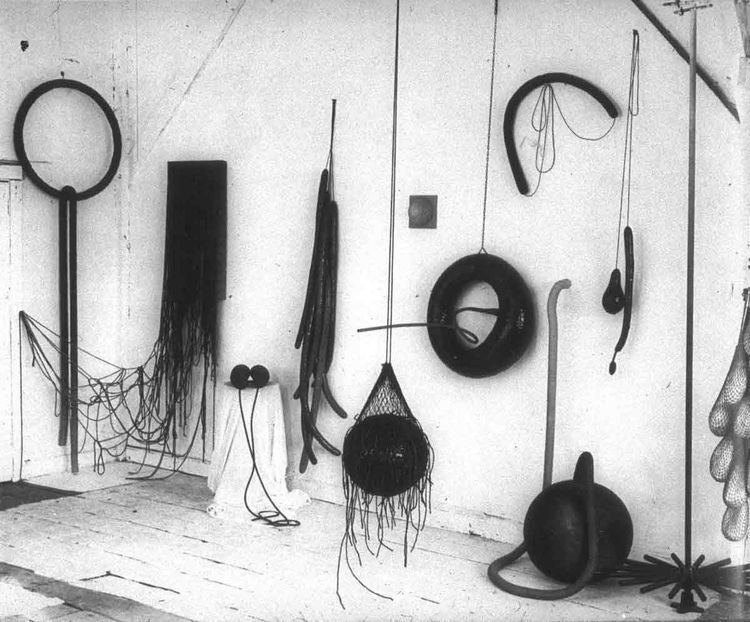
In 1962, Eva married fellow sculptor Tom Doyle, and in 1965, the two moved to Germany so Tom could pursue an artist residency from German industrialist and collector Friedrich Arnhard Scheidt. Hesse and Doyle, whose marriage was coming apart, lived and worked in an abandoned textile mill in the Ruhr region of Germany for about a year. Their studio was set up in a disused part of Friedrich Arnhard Scheidt's textile factory in Kettwig-on-the-Ruhr near Essen. The building still contained machine parts, tools, and materials from its previous use and the angular forms of these disused machines and tools served as inspiration for Hesse’s mechanical drawings and paintings. Hesse was not happy to be back in Germany, but began sculpting with materials that had been left behind in the abandoned factory. Her first sculpture, a relief titled Ring Around Arosie featured cloth-covered cord, electrical wire, and masonite. This year in Germany marked a turning point in Hesse's career. From this point on she would continue to make sculptures, which became the primary focus in her work. Returning to New York City in 1965, she began working and experimenting with the unconventional materials which would become characteristic of her work: latex, fiberglass, and plastic.
Methods, materials, and processes

Hesse's early work (1960–65) consisted of abstract drawings and paintings. She is most well known for her sculptures and because of this, her drawings are often regarded as preliminary steps to her later work. She created her drawings as a separate body of work. She states, "They were related because they were mine but they weren’t related in one completing the other."
Hesse’s interest in latex as a medium for sculptural forms had to do with immediacy. Keats states, "immediacy may be one of the prime reasons Hesse was attracted to latex". Hesse’s first two works using latex, Schema and Sequel (1967–68) use latex in a way never imagined by the manufacturer. "Industrial latex was meant for casting. Hesse handled it like house paint, brushing layer upon layer to build up a surface that was smooth yet irregular, ragged at the edges like deckled paper."
Hesse's work often employs multiple forms of similar shape organized together in grid structures or clusters. Retaining some of the defining forms of minimalism, modularity, and unconventional materials, she created eccentric work that was repetitive and labor-intensive. In a statement of her work, Eva describes her piece titled Hang-Up, "It was the first time my idea of absurdity or extreme feeling came through...The whole thing is absolutely rigid, neat cord around the entire thing . . . It is extreme and that is why I like it and don't like it . . . It is the most ridiculous structure that I ever made and that is why it is really good".
Movements
Eva Hesse is associated with the Postminimal art movement. Hesse is one of the first artists who moved from Minimalism to Postminimalism. Arthur Danto distinguishes it from minimalism by its "mirth and jokiness" and "unmistakable whiff of eroticism", its "nonmechanical repetition".
She worked alongside, and sometimes competed with her male counterparts in post-minimalist art, a primarily male-dominated movement.
Many feminist art historians have noted her work successfully illuminates women’s issues while refraining from any obvious political agenda. She reveals, in a letter to Ethelyn Honig (1965), that a woman is "at disadvantage from the beginning… She lacks conviction that she has the ‘right’ to achievement. She also lacks the belief that her achievements are worthy”. She continues to explain that, “a fantastic strength is necessary and courage. I dwell on this all the time. My determination and will is strong but I am lacking so in self-esteem that I never seem to overcome”. She denied her work was strictly feminist, defending it as feminine but without feminist statements in mind. In an interview with Cindy Nemser for Women's Art Journal (1970) she states, "Excellence has no sex."
Visual and critical analysis
Hesse's work often shows minimal manipulation to a material while simultaneously completely transforming it. Each piece in its simplicity and complexity has driven controversy between art historians. The debate lies in which pieces are to be considered complete and finished works, and which are studies, sketches, or models for future works. Hesse's drawings have been noted as precursory drafts to later sculptures. Her work is often described as anti-form, a term that describes the resistance to uniformity. Her work embodies elements of minimalism in its simple shapes, delicate lines, and limited color palette. Barry Schwabsky described her work for the Camden Arts Centre in London, "Things folded, things piled, things twisted, things wound and unwound; tangled things, blunt things to connect to; materials that have a congealed look, materials that seem lost or discarded or mistreated; shapes that look like they should have been made of flesh and shapes, that look like they might be made of flesh but should not have been – you can look at these things, these materials, these shapes, and feel the shudder of an unnamable nanosensation, or you can let your eye pass by them without reaction; maybe you can do both at once."
Hesse’s work implements a strict color palette. All of her work, and especially her drawings, are based on repetition and simple progressions.
Preservation
Eva Hesse’s sculptures have been the subject of debate in attempts understand how to preserve the pieces that have been deteriorating over the years. Except for fiberglass, most of her favored materials age badly, so much of her work presents conservators with an enormous challenge. Arthur Danto, writing of the Jewish Museum's 2006 retrospective, refers to "the discolorations, the slackness in the membrane-like latex, the palpable aging of the material… Yet, somehow the work does not feel tragic. Instead it is full of life, of eros, even of comedy… Each piece in the show vibrates with originality and mischief."
In some cases, her work is damaged beyond presentation. For instance, Sans III can no longer be exhibited to the public because the latex boxes have curled in on themselves and crumbled. Hesse’s close friend Sol LeWitt argued at a discussion for the conservation, "She wanted her work to last ... She certainly didn't have the attitude that she would mutely sit by and let it disintegrate before her eyes." LeWitt's response is supported by many of Hesse’s other friends and colleagues. However, Hesse’s dedication to material and process question her intention for the permanency of these works. When discussing this topic with collectors in mind, she wrote, "At this point I feel a little guilty when people want to buy it. I think they know but I want to write them a letter and say it's not going to last. I am not sure what my stand on lasting really is. Part of me feels that it’s superfluous, and if I need to use rubber that is more important. Life doesn’t last; art doesn't last."
Legacy
Her art is often viewed in light of all the painful struggles of her life including escaping the Nazis, her parents' divorce, the suicide of her mother when she was 10, her failed marriage, and the death of her father. While experiences no doubt had profound impressions on Hesse, the true impact of her artwork is in her inventive uses of material, her incredibly contemporary response to the minimalist movement, and her ability to usher in the postmodern and postminimalist art movements.
Danto describes her as "cop[ing] with emotional chaos by reinventing sculpture through aesthetic insubordination, playing with worthless material amid the industrial ruins of a defeated nation that, only two decades earlier, would have murdered her without a second thought."
In 2016, a documentary titled Eva Hesse, premiered in New York. Directed by Marcie Begleiter, the film tells the story of Hesse's tragically short life. It "focuses on those years of artistic emergence, a period of rapid development and furious productivity, with few parallels in the history of art."
Prominent artists that have noted her as a primary influence include Japanese artist Eiji Sumi
Exhibitions
In 1961, Hesse's gouache paintings were exhibited in Brooklyn Museum’s 21st International Watercolor Biennial. Simultaneously, she showed her drawings in the John Heller Gallery exhibition Drawings: Three Young Americans. In August 1962, she and Tom Doyle participated in an Allan Kaprow Happening at the Art Students League of New York in Woodstock, New York. In 1963, Hesse had a one-person show of works on paper at the Allan Stone Gallery on New York's Upper East Side. Her first solo show of sculpture was presented at the Kunstverein für die Rheinlande und Westfalen, Düsseldorf, in 1965. In November 1968, she exhibited her large-scale sculptures at the Fischbach Gallery in New York. The exhibition was titled Chain Polymers and was her only solo sculpture exhibition during her lifetime in the United States. The exhibition was pivotal in Hesse's career, securing her reputation at the time. Her large piece Expanded Expansion showed at the Whitney Museum in the 1969 exhibit "Anti-Illusion: Process/Materials". There have been dozens of major posthumous exhibitions in the United States and Europe, including at The Guggenheim Museum (1972), the San Francisco Museum of Modern Art (2002), The Drawing Center in New York (2006) and the Jewish Museum of New York (2006). In Europe, Hesse had a posthumous exhibition in 2010 at the Fundació Antoni Tàpies in Barcelona.
According to the Summer 1979 issue of Artforum, three separate iterations of an Eva Hesse retrospective were held, entitled Eva Hesse: Sculpture. These exhibitions took place at the Whitechapel Art Gallery in London from May 4-June 17, 1979; the Rijksmuseum Kroller-Muller in Otterlo from June 30-August 5, 1979; and the Kestner-Gesellschaft in Hannover from August 17-September 23, 1979. One artwork featured in the exhibition was Aught, four double sheets of latex stuffed with polyethylene. Each is 78 x 40 in.
Hesse had an exhibit from August to October 2009 at the Fruitmarket Gallery, Edinburgh.
